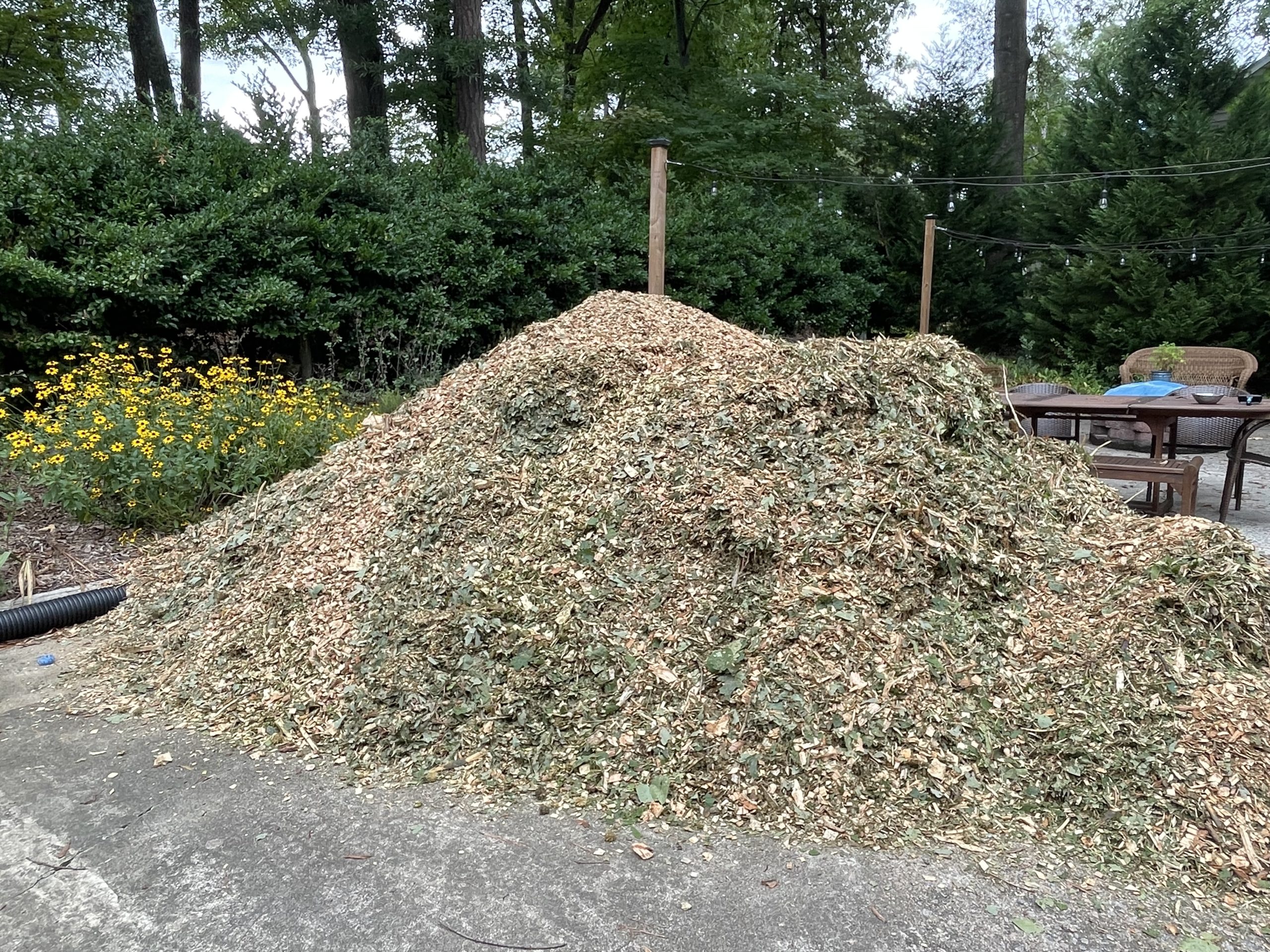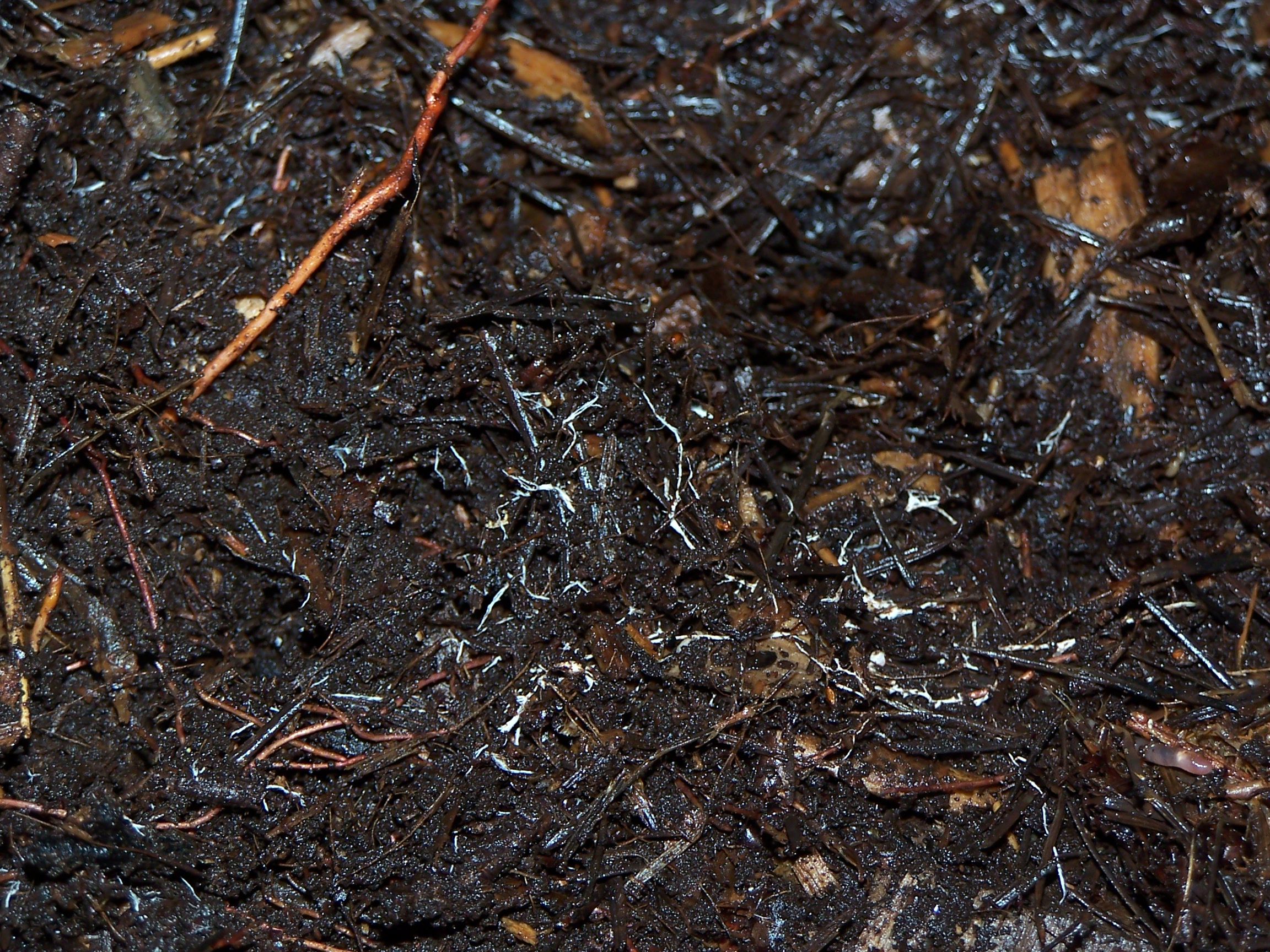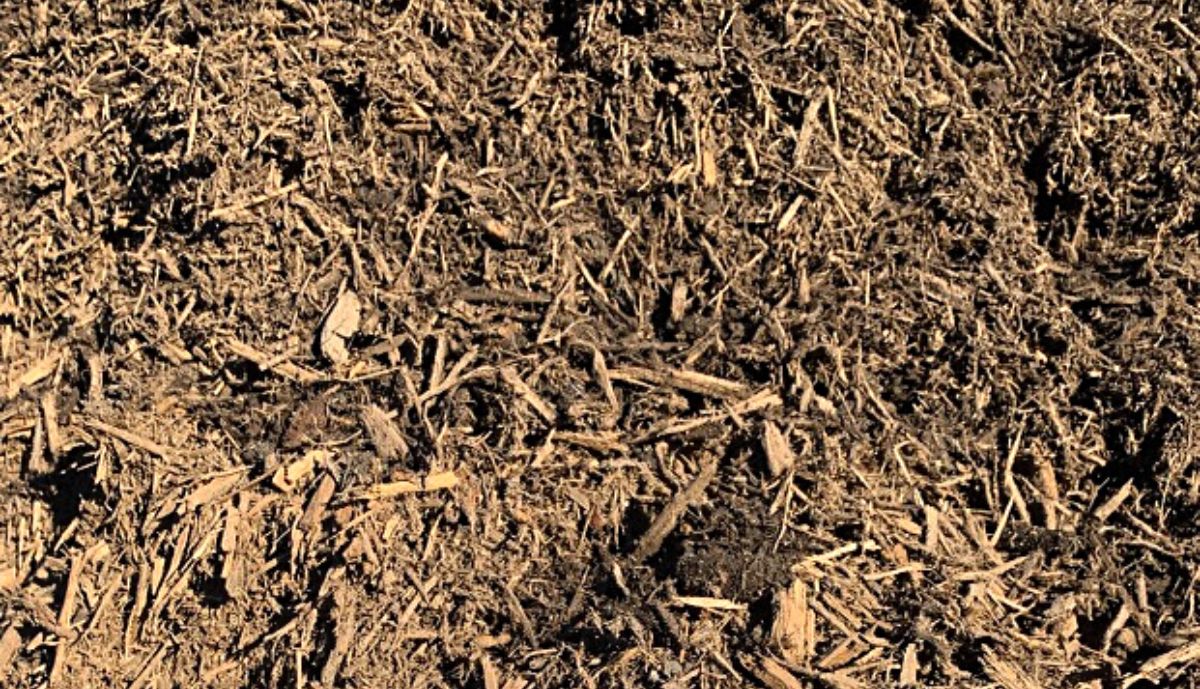Capital Trees Demystifies Mulch Part II
Author: Anna G. Aquino
Let’s rethink living in a bark mulch world, using mulch only as a tool to encourage thriving ecosystems with abundant plants and animals
The best mulch is often free of charge or the least expensive and has the best weed control, moisture holding capacity, temperature moderation, and nutrient availability.
In Demystifying Mulch Part I we described Capital Trees’ sustainable mulching guidelines, promising in Part II to unveil the best mulch to use, and gave the shocking news that it is often free of charge or the least expensive at the mulch yard. (As a reminder, organic mulch is a formerly living material that is spread on top of the soil, as compared to soil amendments that are turned into the soil.) Research shows this mulch has the best weed control, the best moisture holding capacity, is the best at temperature moderation, and has the broadest nutrient availability as it decomposes. Most especially, it is a highly sustainable and recycled product. Capital Trees would like to introduce you to Native Mulch a.k.a Arborist Wood Chips.

Native mulch recently applied at a Capital Trees project.
Native Mulch
Native mulch is fresh tree and brush material that comes directly from arborist chip boxes when arborists prune or remove local trees and shrubs and grind them on site. Native Mulch (aka arborist mulch) is the best mulch.
Native mulch is sustainable, recycled, and local, and using it as a mulch prevents it from having to be transported to landfills. Primarily hardwood chippings, native mulch is also comprised of conifers, brush, bark, heartwood, branches, roots, and the included leaves, buds, shoots, and cambium are highly proteinaceous with an array of nutrient offerings, many times higher in nutrients than bark alone. Kelby Fite, a PhD researcher with Bartlett Tree at their Arboretum in Charlotte, North Carolina advised for this blog. When asked “what is your favorite top shelf premium mulch,” his answer was “Native mulch a.k.a. arborist wood chips. We use it at our 350 acre arboretum, it is recycling at its best. Our research proves that it is the best mulch. We call it the power of wood-based mulch.”
Native mulch encourages biodiversity of beneficial microbes, insects, earthworms, and other animals in the soil who love feeding on this material. Because it is a mixture of plant parts, it decays at various rates and is attractive to an array of insects and decomposers as compared to bark. This diverse community of life leads to an ecosystem more resistant to environmental disturbance and one that supports healthier plants and animals. Water easily moves through it and it has exceptional moisture retention.(1)
Native mulch does not have the uniformity of most bark mulches, but it does look like what occurs on the ground in a natural mixed woody and perennial plant setting, where plant debris falls and decays. Most experts say they favor applying fresh native mulch as opposed to composted native mulch because it is higher in protein. As it decomposes, native mulch stores extremely valuable energy in its chemical bonds in the proper form for beneficial soil organisms to use, providing a long-term energy source that promotes a healthy food web and a superior soil structure. As a weed control measure it is excellent because it knits together so nicely. In addition, its multi-size structure and coarse shredded texture promote aeration of the soil below, resisting compaction. Applying 3 inches suppresses weeds; watering it in helps it lie nicely. It is highly biologically active, and microbes will use stored nitrogen in the decomposing leaves of the mulch. Native mulch will also help break down clay particles in soil, loosening the soil and improving drainage. Mycorrhizal fungi are vital for healthy woody plants and perennials and they flourish in it, in contrast pine bark mulch can suppress fungi.(2)

Fungal hyphae in a wood chip mulch. Linda Chalker-Scott photo, with permission.
Linda Chalker-Scott, considered the mulch guru, from Washington State University, is an excellent source of information on arborist wood chips. Look for her many publications on native mulch and sustainable gardening. She has contributed to this blog, answering questions via email. Regarding weed management and native mulch, she admits the mechanism is not fully understood, but theorizes it is possibly due to nitrogen deprivation at the mulch-soil interface. As the high carbon native mulch decomposes it uses nitrogen at that interface and inhibits weed seed germination. She writes that the nitrogen deficiency is just at the interface and does not influence plant roots whatsoever. She also surmises that the chunkiness of it kills existing small weeds by blocking sunlight. Regarding nitrogen being tied up by wood chips, robbing it from plant roots, Dr. Fite of Bartlett Arboretum tells us, “The mulch is applied to the surface and it will not affect the soil, however if one amends with it (turns the mulch into the soil) it could be more concerning and you could deplete the soil nitrogen and have to offset with compost. But mulching with native mulch in no way changes the nitrogen composition and availability in the soil. It is not a concern.” (3,4)
Dr. Chalker-Scott and others’ experiments have proven that native mulch does not detrimentally affect the nitrogen in the soil or the soil pH. Her field research shows us that native mulch is especially effective at helping establish trees and native plants from the seed bank in urban and disturbed environments, and is excellent for use at restoration sites. In the scientific journal Ecological Restoration from the University of Wisconsin Press, she published a field experiment comparing installing 12 inches of native mulch versus using the herbicide RoundUp to eliminate weeds and grow planted snowberries. The native mulch was far more successful in the short and long terms eliminating the invasive plants, improving the soil, promoting snowberry plant survival, and volunteer native plant survival. It is an absolutely amazing piece of research.(5,6) View a talk regarding this experiment and her other research about native mulch in this HERE. Dr. Chalker-Scott tells us that native mulch decomposes slowly, providing a steady nutrient stream. Similarly, it absorbs lots of water and slowly releases it to the soil and plants. Native mulch is not suggested for vegetable gardens, annual plantings, or areas meant for seed germination; for an explanation of this and more on the subject of native/arborist mulch she is your best resource.
For free native mulch go to https://getchipdrop.com/. For so-called “economy mulch,” go to Mulch Unlimited and encourage your favorite garden supply company to sell it.
Bark Mulch
Bark mulch is a commonly used mulch composed of the shredded outer protective layer of trees.
While bark mulch is popular for its visual consistency, its drawback is implied in its name – bark is an outer protective layer composed of substances such as suberin, a waxy waterproofer meant to protect trees from environmental challenges thus resists decay. In addition, bark mulch is low in nutrients, and those provided upon decay are not high value plant nutrients, as compared to the broad spectrum of nutrient offerings of native mulch. Bark is low in energy-releasing compounds and energy is key to the flourishing of microorganisms that are necessary for a healthy soil. Pines are pioneer species indicating that they grow on nutrient deficient soils; therefore contain even fewer nutrients than hardwood bark, and the chemicals present in pine bark kill beneficial microbes.(7,8,9) Dr. Fite with Bartlett Tree when asked if one is set on using bark mulch, which is the best and his answer was “Second to native mulch would be shredded/double shredded hardwood mulch. You are getting some heartwood when you think you’re just getting bark. The mulch will decay and return some nutrients to the soil and as we know mulch provides lots of services not just nutrients. Shredded hardwood is the best bark mulch at helping grow your fungal network for perennials and trees and shrubs.” Howard Garrett, author of Organic Management for the Professional, informs us that there is abundant peer reviewed research proving that pine and conifer bark mulches release toxic volatile compounds that are harmful to certain plants. He contends that many tree biologists, arborists, soil ecologists, including the luminary Father of Modern Arboriculture Alex Shigo, do not support the use of bark mulches, especially coniferous. He reports that beneficial microorganisms are killed by naturally occurring chemicals in pine bark. More citations are noted in the above mentioned book.
Leaf Mulch
Leaf mulch is using the natural falling leaves as mulch.
Using leaves as mulch, whether it’s full-sized leaves fallen from your trees, shredded leaves, or composted leaves, is beautiful recycling at its best. It gives back to plants the exact minerals that comprise them, that sustain them. In fact 50 to 80% of all the elements trees extract from the soil with the help of microbes end up in the leaves. Leaves of most trees contain twice the mineral content of manure for the same weight, and contain abundant trace elements. They are roughage that improve drainage and aeration, and provide excellent nutrition for beneficial microbes.(10) Leaving in place fallen full-sized leaves as well as raking and piling them is an essential way to protect the pollinators and other insects you watched and relished all spring, summer, and fall. In winter they inhabit leaf litter, hollow stems and decaying brush, and burrow into soil. The Xerces Society for Invertebrate Conservation tells us the best way to help is to “simply do nothing!” and leave the leaves. (11) (Along with area partners, Capital Trees is sponsoring Bee City USA Richmond.) (12) But remember native mulch provides not only the leaves but also the high in protein stems, buds, cambium—everything. Linda Chalker-Scott told Capital Trees that leaf mulch is not a good substitute for arborist mulch because it is too fine and too rich. As good as leaf mulch is, plants and their microbes do best under a decaying arborist mulch. Augment the native mulch with your autumn leaves, so that the music of fall is more bird than blower.
When we initiated our sustainable practices commitment approximately three years ago at Capital Trees’ Low Line, we mulched with shredded leaf litter. It was a great beginning and a learning experience. The leaf mulch decayed too quickly, by late summer in our intense urban setting, and the nutrient rich surface was extra attractive to weeds. We do highly recommend leaving your leaves and allowing them to decay in your planting beds, along with the installation of native mulch. Capital Trees continues to add the naturally falling leaves to our garden beds as one mulching practice.
Living Mulch
Living mulch is using groundcover plants to cover the soil and provide the same benefits of mulch (nutrients, water retention, temperature regulation, and weed control).
Using groundcover plants as mulch reduces the need for mulch application, and can ultimately replace the need for any mulch. They reduce soil erosion, reduce surface water runoff, can fix nitrogen in the soil, improve soil structure, recycle nutrients, attract pollinators, and those heavy in essential oils (examples, dwarf rosemary, oregano, thyme) can be used as plant pest and deer repellents. They can crowd out weed infestation, improve compaction, increase soil beneficial insects and microbes, and improve water filtration into the soil. There are various categories of plants as mulch—living mulch, green manure, cover crops, green mulch—some are meant to be removed after providing their valuable ecological services, and if adhering to no-till garden management, the removed plants can simply be left in the bed to decay and contribute to the humus layer, or they can be composted. Some living mulches are maintained as permanent groundcovers, offering great benefits to the garden.
Three Capital Trees’ recommendations are Carex eburnea (ivory sedge, native to western Virginia), Chrysogonum virginianum (Green and Gold, native throughout Virginia), Packera aurea (Golden Ragwort, native throughout Virginia).
- Using Arborist Wood Chips as a Landscape Mulch (Home Garden Series)
- Wood chip mulch: Landscape boon or bane?
- The Dirt Doctor
- Garrett, Ferguson, Amaranthus (2012) Organic Management for the Professional: The Natural Way for Landscape Architects and Contractors, Commercial Growers, Golf Course Managers, Park, Turf Managers, and Other Stewards of the Land
- Wonderful wood chips
- Wood-chip mulch improves plant survival and establishment at no-maintenance restoration site
- Garrett, Ferguson, Amaranthus (2012) Organic Management for the Professional: The Natural Way for Landscape Architects and Contractors, Commercial Growers, Golf Course Managers, Park, Turf Managers, and Other Stewards of the Land
- The Myth of Pretty Mulch “Bark mulch and sawdust are aesthetically preferable to wood chips and they work just as well”
- LINDA CHALKER-SCOTT. Horticultural Myths
- Using Autumn’s Bounty
- Leave the Leaves
- Bee City USA


